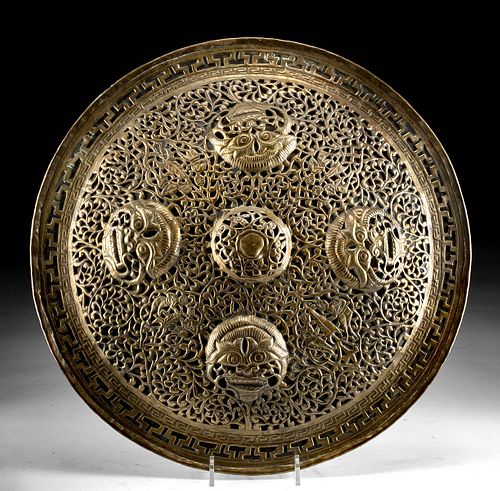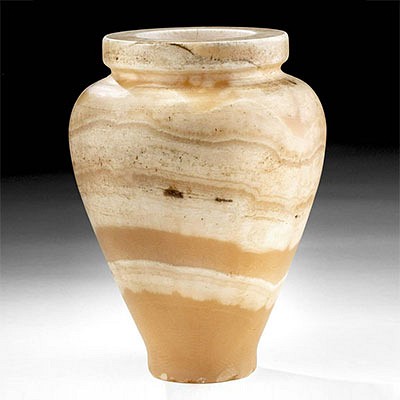Antique Indian Brass Dahl / Shield with Monster Heads
Lot 68
About Seller
Artemis Gallery
686 S Taylor Ave, Ste 106
Louisville, CO 80027
United States
Selling antiquities, ancient and ethnographic art online since 1993, Artemis Gallery specializes in Classical Antiquities (Egyptian, Greek, Roman, Near Eastern), Asian, Pre-Columbian, African / Tribal / Oceanographic art. Our extensive inventory includes pottery, stone, metal, wood, glass and textil...Read more
Categories
Estimate:
$600 - $900
Absentee vs Live bid
Two ways to bid:
- Leave a max absentee bid and the platform will bid on your behalf up to your maximum bid during the live auction.
- Bid live during the auction and your bids will be submitted real-time to the auctioneer.
Bid Increments
| Price | Bid Increment |
|---|---|
| $0 | $25 |
| $300 | $50 |
| $1,000 | $100 |
| $2,000 | $250 |
| $5,000 | $500 |
| $10,000 | $1,000 |
| $20,000 | $2,500 |
| $50,000 | $5,000 |
| $100,000 | $10,000 |
| $200,000 | $20,000 |
About Auction
By Artemis Gallery
Dec 17, 2020
Set Reminder
2020-12-17 10:00:00
2020-12-17 10:00:00
America/New_York
Bidsquare
Bidsquare : VARIETY SALE | Antiquities & Ethnographic Art
https://www.bidsquare.com/auctions/artemis-gallery/variety-sale-antiquities-ethnographic-art-6207
Featuring classical antiquities, ancient and ethnographic art from cultures encompassing the globe. Egyptian, Greek, Roman, Etruscan, Near Eastern, Asian, Pre-Columbian, Native American, African / Tribal, Oceanic, Spanish Colonial, Russian, Fossils, Fine Art, more! Artemis Gallery info@artemisgallery.com
Featuring classical antiquities, ancient and ethnographic art from cultures encompassing the globe. Egyptian, Greek, Roman, Etruscan, Near Eastern, Asian, Pre-Columbian, Native American, African / Tribal, Oceanic, Spanish Colonial, Russian, Fossils, Fine Art, more! Artemis Gallery info@artemisgallery.com
- Lot Description
Central Asia, Pakistan/northern India, Indo-Persian period, ca. 19th century CE. An attractive brass shield known as a dhal, a form of buckler, or small shield made to be gripped with a central handle on the verso - presenting a round, convex form with a decorative openwork overlay with five large bosses. Four of the bosses represent monstrous maskettes with fearsome, toothy visages delineated in repousse and openwork. These are set equidistantly around the central one which features floral vines surrounding a circular tiered boss with a raised nodule at the center. The rest of the shield presents a profusion of amazing imagery - most of which is floral and phytomorphic, however upon close examination one can also see four pairs of human figures between the bosses. Size: 13.875" W (35.2 cm)
Framing the composition is a recessed border comprised of a narrow band of engraved running meander followed by a wider band of openwork alternating upright and inverted "T" motifs. This type of shield demonstrates the Persian influence on Indian culture that was present during the Mughal Empire, which lasted from the 16th to 19th century CE.
Please note, the lucite stand is for photographic purposes only.
Provenance: private northern California, USA collection; ex-Alex Shimonauff collection
All items legal to buy/sell under U.S. Statute covering cultural patrimony Code 2600, CHAPTER 14, and are guaranteed to be as described or your money back.
A Certificate of Authenticity will accompany all winning bids.
We ship worldwide and handle all shipping in-house for your convenience.
#153376Normal surface wear commensurate with age and minor indentations to central boss. Handle soldered to shield at a slight angle but still functional. Brass has developed a warm patina over time. Decorative program is strong.Condition
- Shipping Info
-
All shipping is handled in-house for your convenience. Your invoice from Artemis Gallery will include shipping calculation instructions. If in doubt, please inquire BEFORE bidding for estimated shipping costs for individual items.
-
- Buyer's Premium



 EUR
EUR CAD
CAD AUD
AUD GBP
GBP MXN
MXN HKD
HKD CNY
CNY MYR
MYR SEK
SEK SGD
SGD CHF
CHF THB
THB














